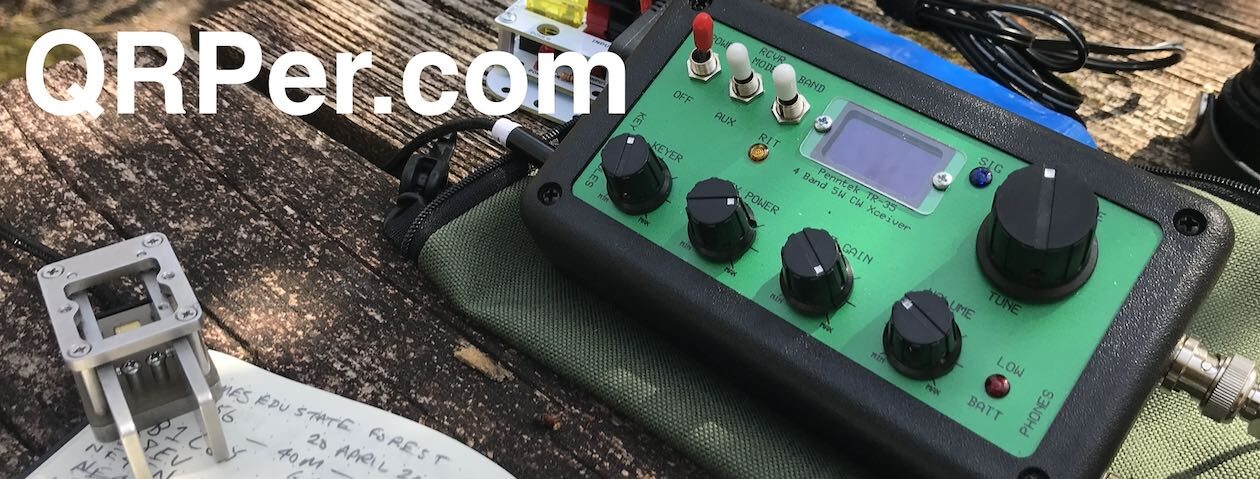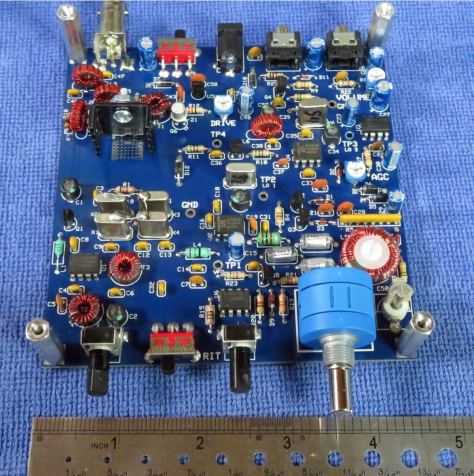Many thanks to Dick (K7ULM) who shares the following guest post:
 The Best Mountain Topper Antenna
The Best Mountain Topper Antenna
(And a modification that makes it a little better)
by Dick (K7ULM)
When I decided to pursue HF radio, I had already decided to learn Morse Code. Since learning code on my own wasn’t working, I enrolled in CW Academy classes. Nearly everyone that I met in the CW Academy classes, plus my Elmer, were all involved in QRP portable ops as well. A common theme among them all was using efficient, lightweight, easy to deploy antennas.
New to ham radio, QRP, and antennas. I started to research antennas that fit that set of criteria. Of course, I stumbled onto K6ARK, Adam Kimmerly’s YouTube video on building an ultralight 40m EFHW. I accumulated the parts and built an EFHW for 40m. After tuning the antenna for the lowest SWR, I connected it to a KX3 and contacted hams in Long Island, NY and Atlanta, GA with 12watts using SSB. I was hooked on QRP and Adam’s antenna design.
When the instructor in my CW Academy class asked what goals each of us had for ham radio, I realized that I had no real goals. So, I told the group that I wanted to assemble a portable QRP kit that weighed under one pound, and I wanted to operate portable CW from my elk hunting camp in the fall. The sub-one pound HF kit was inspired by SOTA guru and legend, Fred Mass, KT5X. I ordered an MTR-3B (Mountain Topper 3b – a QRP CW transceiver), which arrived 2 days before I left for elk camp. The sub one pound HF kit had become reality.
At elk camp, I was a little distressed that I couldn’t work 30m with the EFHW, but 20m and 40m were a great combination. Three nights later I was laying on a cot in a canvas wall tent in elk camp scanning the bands and trying to decode signals as I found them. I heard one signal calling CQ for a long time and decided to try to answer him with my very limited CW skills. I was able to get the minimum information to make an official QSO. Looking up the contact’s information on QRZ, I found that it was Lloyd, KH6LC in Keaau, HI, 3000+ miles from elk camp. Hawaii worked on 5 watts. I was totally hooked on QRP and CW.
The only problem with the 40m EFHW, is that it doesn’t tune up easily on 30m. Adam’s 40m EFHW design is excellent, and I wanted to stay with his build design, so I concluded that I needed to put a 30m link in mine EFHW to cover 40m, 30m and 20m without the use of a tuner. My first effort on building a 30m link worked well but it was heavy and rigid which made it hard to store. Eventually I created a design for the link that met my goals.
How to build lightweight links
My goals for a link on a lightweight EFHW are that it needs to be lightweight and flexible for easy storage. It should also be relatively clean in design to minimize the chance of hanging up in trees and bushes while deploying and retrieving the antenna.
The materials for the link design that are currently working the best for me are as follows:
- Attwood 3/32” tactical cord.
- Heat shrink tube.
- Superglue. Gel type is the least messy.
2mm bullet connectors, or a more solid connection, red knife disconnects from Aircraft Spruce and Specialties Co. https://www.aircraftspruce.com/catalog/elpages/knifedisc.php
The knife disconnects idea is from Charlie Brown of Red Summit RF. They are worth looking into. They are my current choice of connector although the bullet connectors are working OK.


The installation of this link is fairly simple.
The first step is to tune a 30m section of wire on your preferred transformer. The narrow 30m band will normally be well below 1.5:1 across the entire band, which is awesome. I have found that it is about 32’ 7” of wire for my deployment style and soil conditions. Your mileage will vary. You can cut this into an existing antenna but, plan on adding a piece of wire to the end of the antenna to retune it for 20m and 40m. For an existing antenna, measure the overall length from the transformer to the end of the antenna prior to cutting in the link. You will use this measurement to restore the overall length of the antenna for the 40m EFHW.
Step two is to cut two pieces of heat shrink tube that will fit over your selected antenna wire and the 3/32” cord. Slide one piece of tube onto the newly tuned 30m wire and the other onto the wire that will be tuned for the final 40m EFHW. I use 26ga Polysteath wire.
Step three, cut two pieces of shrink tube to cover the solder joint of the wire connectors and slide one piece of tubing on both wires.
Step four, solder the connectors onto the 30m and 40m wire sections. When cool, slide the shrink tube onto the solder joint and shrink.
Step five, cut about 6.5” of cord and melt the ends of the cord. Mark the center of the cord so you can center it on the connectors. Center the cord on the connectors and slide the shrink tube over one end of the cord. Leave the final location of the shrink tube exposed for glue. Put a couple of drops of superglue on that area, slide the shrink tube into its final placement and shrink in place.
Step six, slide the shrink tube onto the other side of the cord and leave a little room to put glue on the cord as was done on the first end. For strain relief on the connection, it is best to put some slack in the wire, so the full load of the antenna is placed on the cord and not on the connection. The easiest way I have found to do this is to disconnect the connectors and overlap them by ¼” or so prior to shrinking the second shrink tube into place. Once everything is ready, put a couple of drops of superglue on the cord, slide the tube into place and shrink.
When you reconnect the connectors, there should be a bit of slack in the wire that prevents any pull on the connectors while the antenna is deployed. At this point restore the full original length of your antenna for add a new section of wire and tune for 40m and 20m as desired.
With K6ARK’s ingenious EFHW design and a 30m link, you can have a fantastic antenna matched to the MTR3B that is, tuned for resonance on 40m, 30m, and 20m, easy to deploy and weights under 2oz. If you add one of Adam’s 3D printed paddles, a couple of 500mAHr LiPo batteries, and earphones your complete HF kit will be about 12oz. Add a Carbon 6 mast and your total kit come in at a mere 23.7oz. WINNING!


For those operators who are fortunate enough to own an MTR4B, an 80m removable extension can be added to the 40m EFHW using a similar technique. On the 40m EFHW, prior to installing the connector, a piece of the cordage can be folded back on itself to create a loop and slid through a piece of shrink tube. This loop works as a good connection point for your guy lines while deploying the 40m antenna by itself and a place to tie on the 80m extension when needed.
For the 80m section, a single 5” length of cord will be connected to the wire to tie with superglue and shrink tube. Solder the connector onto the 80m section before securing the cord. The cord on the 80m extension is to tie the antenna sections together in a manner to provide strain relief for the couplers. A cord loop can be put on the far end of the 80m section using this technique after it is tuned.



This is my vote for the best Mountain Topper portable easy to deploy antenna, or for any QRP radio without an ATU. IMHO.












































